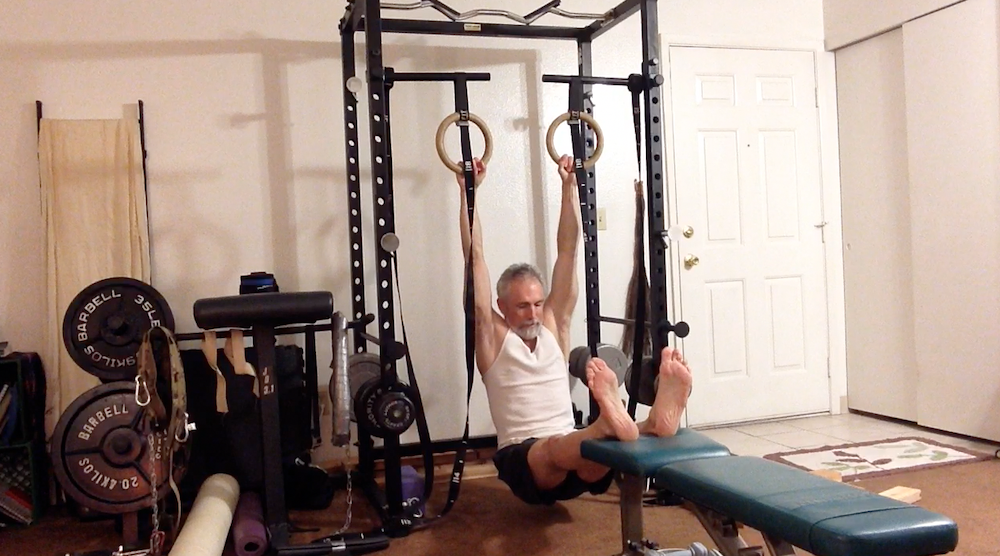Horizontal Pulling Options
So you want to gain some upper back strength and size?
Horizontal pulling develops the trapezius, latissimus dorsi, biceps and forearms.
Due to the complexity of the upper back muscles, I recommend including both chin ups and a horizontal pulling exercise in the Get Strong! program.
Chin ups are the best vertical pulling multi-joint exercise for the latissimus dorsi and biceps, but they do not properly load the trapezius function of scapular retraction. To properly train the trapezius you need inverted rowing or fulcrum 90º pull ups to the sternum.
Basic Horizontal Pulling: Inverted Rowing
Inverted rowing is easier than 90º pull ups to the sternum, so many people will have to use this exercise when they start the Get Strong! program.
Inverted rowing is safer than rowing with barbell because you do not bend over at the waist, removing strain from the lower back.
Inverted rowing involves the shoulder girdle in keeping the body parallel to the ground, as in a front lever. This results in greater upper back activation IF you use adequate resistance.
 |
 |
Inverted Rowing with Feet Elevated
Inverted rowing should be done using a supinated or neutral grip.
If using a single bar, use a supinated grip. This puts the biceps in their strongest pulling position so they do not limit the load you can put on the upper back. Bret Contreras found that the supinated (underhand) grip inverted row with feet elevated produced one of the three greatest peak lat activations.
If you have rings or a suspension trainer you can use a neutral grip or what I find most comfortable, a neutral grip in the bottom position (arms extended) and active supination as you pull into the contracted position.
You can adjust the difficulty of inverted rowing easier by changing the height of the rings or bar. A higher bar/rings set up makes the movement easier.
Assuming the table position (knees bent) so the lever arm is shorter also makes it easier.
You progress by lowering the bar or straightening the legs, then progressively raising the legs so that your body is parallel to the floor in the extended position.
Once you can do the inverted row with the feet elevated you can progressively load the inverted row by using two Cartman tie down straps tied together, loaded with barbell plates which are secured to the straps by carabiners which prevent the plates from sliding off the straps. You then lay the straps across your abdomen with plates evenly distributed on each side of your body.
Advanced Horizontal Pulling: Fulcrum 90º Pull Ups
When you are strong enough to do inverted rowing with feet elevated you may be able to do fulcrum 90º pull ups a.k.a. sternum pull ups.
If you can scale fulcrum 90º pull ups to your ability, you should do these rather than inverted rowing in the Get Strong! program.
 |
 |
 |
Fulcrum 90º Pull Up
This video shows another way to do the fulcrum 90º pull up on a straight bar. This is more difficult than as depicted above because the torso is brought to horizontal to the floor, whereas in the photos above the torso is about 45º to the floor.
These improve on inverted rowing by enabling you to work the upper back through a greater range of motion.
You can progress the difficulty by using the 4-zone method as shown in the video below.
Horizontal Pulling Summary
If you can't do fulcrum 90º pull ups yet, do inverted rowing until you can.
If you can do fulcrum 90º pull ups, they should be your staple for horizontal pulling until you can do 90º pull ups without your feet supported.
Recent Articles
-
Ancient Roman Soldier Diet
Apr 14, 25 05:19 PM
A discussion of the ancient Roman soldier diet, its staple foods and nutritional value, and a vegan minimalist version. -
High Protein Chocolate Tofu Pudding
Jul 01, 24 12:41 PM
A delicious high protein chocolate tofu pudding. -
Vegan Macrobiotic Diet For Psoriasis
Sep 05, 23 06:36 PM
Vegan macrobiotic diet for psoriasis. My progress healing psoriasis with a vegan macrobiotic diet. -
How Every Disease Develops
Aug 04, 23 06:22 PM
How every disease develops over time, according to macrobiotic medicine. -
Why Do People Quit Being Vegan?
Jun 28, 23 08:04 PM
Why do people quit being vegan? How peer pressure and ego conspire against vegans. -
Powered By Plants
Mar 16, 23 08:01 PM
Powered By Plants is a book in which I have presented a lot of scientific evidence that humans are designed by Nature for a whole foods plant-based diet. -
Carnism Versus Libertarianism
Dec 30, 22 01:55 PM
Carnism Versus Libertarianism is an e-book demonstrating that carnism is in principle incompatible with libertarianism, voluntaryism, and anarchism. -
The Most Dangerous Superstition Book Review
Nov 15, 22 08:46 PM
Review of the book The Most Dangerous Superstition by Larken Rose.











